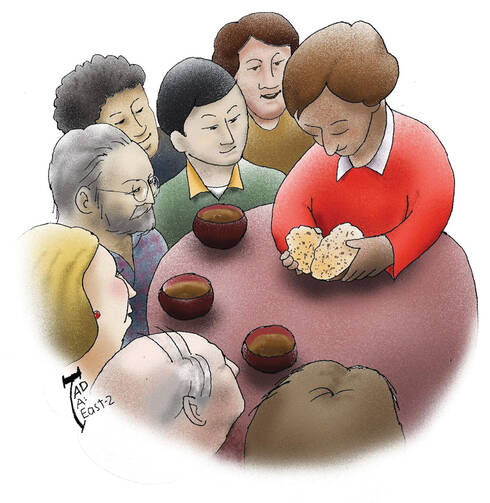Radical Witness
Shortly after the ascension, the number of believers in Jerusalem was about 120, according to Acts 1:15. Whether the number is exact or symbolic of a restored Israel, the church started small.
The crowds who pressed around Jesus in Galilee and greeted him during his triumphant entry into Jerusalem were gone. The believing community consisted of a small group who had not only followed him through the crucifixion, but were giving testimony to the resurrection. When the apostles chose a 12th apostle to replace Judas, the criterion was that the disciple chosen must have been present from the “baptism of John until the day when he was taken up from us—one of these must become a witness with us to his resurrection.”
There is good reason that Easter is the center of the church’s witness and its origin: without the belief that Jesus had been raised from the dead, to what would these followers of Jesus have borne witness? How could they have carried on as church? It was through the resurrection that they understood Jesus was Lord and that salvation came through his name. Their mission, which they chose to accept, was “that you may come to believe that Jesus is the Messiah, the Son of God, and that through believing you may have life in his name.” But how would 120 people bear witness to the world?
There was no blueprint for the church as to how to evangelize and worship, nor “Seven Easy Steps to Start Your Religion” and not even a focus group or a PR firm. One of the great shocks of Jesus’ mission is how large a role was given to the nascent church to fulfill Jesus’ earthly ministry. It would be up to the disciples of Jesus to take what he had taught them and what they had witnessed and reflect on all they had experienced in order to bring the message to the world. Yet within decades the church had spread throughout the Mediterranean world and beyond. What is even more surprising than the rapid extent of their reach was the combination of radical and ordinary in the establishment of the church’s witness.
Though the first Christians felt the press of the eschaton, they spent time on the ordinary acts of living and worshiping together. Acts tells us that the first followers “devoted themselves to the apostles’ teaching and fellowship.” The teaching must have been the oral tradition of Jesus’ own instruction and the recounting of the events of his passion, as well as understanding Jesus in the context of the Scriptures. The fellowship (koinonia) certainly included the teaching and “the breaking of bread and the prayers,” but even more fundamentally the sense of oneness in their communion. The breaking of the bread signals the eucharistic celebration in nascent form, but we should not overlook the actual sharing of meals together that marks community. Later Acts speaks of how “they broke bread at home and ate their food with glad and generous hearts.” Prayer would have been central to their lives even prior to following Jesus, and it remained at the core of their communal life together.
In fact, the communion the early disciples experienced with each other might be seen as the fulcrum between the ordinary and the radical. It was in the love of neighbor and God gained through discipleship with Jesus, the penetration of God’s word of mercy and grace and the communion of the Holy Spirit among them that decisions were made that radicalized this band of followers. We are told that “all who believed were together and had all things in common.” This was not simply generous sharing, but radical transformation of the place of worldly goods.
The earliest disciples “would sell their possessions and goods and distribute the proceeds to all, as any had need.” Material goods were necessary to meet the needs of daily life; they were necessary so they could witness to salvation in Jesus. They did not choose mansions, fortune or fame, however, but the communal life and radical sharing of goods in order to better witness to Jesus so that all might believe. Acts says that “many wonders and signs were being done by the apostles,” but the greatest wonder is that their ordinary lives and choices powerfully bore witness to Jesus as the primary goal of their mission.
This article also appeared in print, under the headline “Radical Witness,” in the April 21, 2014, issue.








